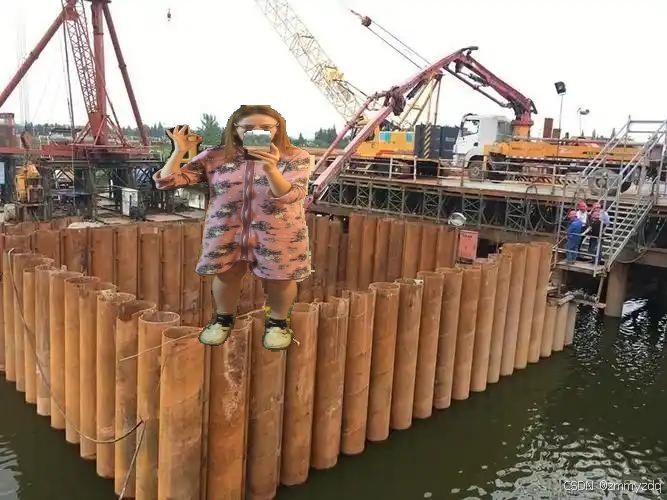yolov8检测掩码目标,并与背景融合
剪切代码如下:
import os
from ultralytics import YOLO
import numpy as np
import cv2
# Load YOLO model
model = YOLO("/home/zm/PycharmProjects/yolo/ultralytics-main/yolov8m-seg.pt")
# Define input and output directories
input_dir = '/media/ZM/ZM/数据/ok/person_ok_clothes_helmet(train)/train_down/'
output_dir = '/media/ZM/ZM/数据/ok/seg_result/'
# Ensure the output directory exists
os.makedirs(output_dir, exist_ok=True)
# Loop through all image files in the directory
for img_name in os.listdir(input_dir):
# Only process jpg images
if img_name.endswith('.jpg'):
# Construct the full file path
img_path = os.path.join(input_dir, img_name)
# Read the image
orig_img = cv2.imread(img_path)
# Resize the image to match the model input size (448x640)
orig_img_resized = cv2.resize(orig_img, (640, 448)) # Note OpenCV uses (width, height)
# Run inference on the image
results = model(source=img_path, save=False, device='0', project=output_dir,classes=[0])
# Get the mask data
mask = results[0].masks.data[0].cpu().numpy().astype(np.bool_)
# Resize the mask to the same dimensions as the resized image
mask_resized = cv2.resize(mask.astype(np.uint8), (640, 448), interpolation=cv2.INTER_NEAREST).astype(np.bool_)
# Apply the resized mask to the original image
masked_image = np.zeros_like(orig_img_resized)
masked_image[mask_resized] = orig_img_resized[mask_resized]
# If you want a transparent background (RGBA)
alpha_channel = np.ones(mask_resized.shape, dtype=orig_img.dtype) * 255 # Create the alpha channel
masked_image_rgba = np.dstack((masked_image, alpha_channel)) # Add the alpha channel to RGB
masked_image_rgba[~mask_resized] = (0, 0, 0, 0) # Make the non-mask areas transparent
# Save the image with a transparent background (RGBA)
output_path_rgba = os.path.join(output_dir, f"masked_{img_name.replace('.jpg', '_rgba.png')}")
cv2.imwrite(output_path_rgba, masked_image_rgba)
# # Save the image with a black background
# output_path_black_bg = os.path.join(output_dir, f"masked_{img_name}")
# cv2.imwrite(output_path_black_bg, masked_image)
print(f"Processed and saved: {img_name}")
融合代码代码如下:
import cv2
import numpy as np
import os
import random
def add_alpha_channel(img):
"""为jpg图像添加alpha通道"""
b_channel, g_channel, r_channel = cv2.split(img) # 剥离jpg图像通道
alpha_channel = np.ones(b_channel.shape, dtype=b_channel.dtype) * 255 # 创建Alpha通道
img_new = cv2.merge((b_channel, g_channel, r_channel, alpha_channel)) # 融合通道
return img_new
def resize_image_aspect_ratio(img, target_width, target_height):
"""按比例调整PNG图像大小,使其宽度不超过500,高度不超过1080"""
h, w = img.shape[:2]
aspect_ratio = w / h
# 设置最大宽度和高度限制
max_width = 500
max_height = 1080
# 计算目标尺寸,保持宽高比
if w > h:
new_width = min(max_width, w)
new_height = int(new_width / aspect_ratio)
else:
new_height = min(max_height, h)
new_width = int(new_height * aspect_ratio)
# 如果调整后的宽度或高度超过限制,进行适当缩放
if new_width > max_width:
new_width = max_width
new_height = int(new_width / aspect_ratio)
if new_height > max_height:
new_height = max_height
new_width = int(new_height * aspect_ratio)
# 调整大小
resized_img = cv2.resize(img, (new_width, new_height))
return resized_img
def merge_img(jpg_img, png_img, y1, y2, x1, x2):
"""将png透明图像与jpg图像叠加"""
# 判断jpg图像是否已经为4通道
if jpg_img.shape[2] == 3:
jpg_img = add_alpha_channel(jpg_img)
# 叠加图像位置的限制,避免超出范围
yy1 = 0
yy2 = png_img.shape[0]
xx1 = 0
xx2 = png_img.shape[1]
if x1 < 0:
xx1 = -x1
x1 = 0
if y1 < 0:
yy1 = -y1
y1 = 0
if x2 > jpg_img.shape[1]:
xx2 = png_img.shape[1] - (x2 - jpg_img.shape[1])
x2 = jpg_img.shape[1]
if y2 > jpg_img.shape[0]:
yy2 = png_img.shape[0] - (y2 - jpg_img.shape[0])
y2 = jpg_img.shape[0]
# 获取要覆盖图像的alpha值,将像素值除以255,使值保持在0-1之间
alpha_png = png_img[yy1:yy2, xx1:xx2, 3] / 255.0
alpha_jpg = 1 - alpha_png
# 开始叠加
for c in range(0, 3):
jpg_img[y1:y2, x1:x2, c] = ((alpha_jpg * jpg_img[y1:y2, x1:x2, c]) + (alpha_png * png_img[yy1:yy2, xx1:xx2, c]))
return jpg_img
def random_overlay(jpg_img, png_images_dir, max_overlays=3):
"""在JPEG图像上随机叠加1到max_overlays张PNG图像"""
# 获取PNG图像路径列表
png_files = [f for f in os.listdir(png_images_dir) if f.endswith('.png')]
# 随机选择1到max_overlays个PNG图像
num_overlays = random.randint(1, max_overlays)
selected_png_files = random.sample(png_files, num_overlays)
for png_file in selected_png_files:
png_path = os.path.join(png_images_dir, png_file)
png_img = cv2.imread(png_path, cv2.IMREAD_UNCHANGED)
# 调整PNG图像的大小
png_img_resized = resize_image_aspect_ratio(png_img, jpg_img.shape[1], jpg_img.shape[0])
# 随机选择叠加位置
x1 = random.randint(0, jpg_img.shape[1] - png_img_resized.shape[1])
y1 = random.randint(0, jpg_img.shape[0] - png_img_resized.shape[0])
x2 = x1 + png_img_resized.shape[1]
y2 = y1 + png_img_resized.shape[0]
# 开始叠加
jpg_img = merge_img(jpg_img, png_img_resized, y1, y2, x1, x2)
return jpg_img
if __name__ == '__main__':
# 定义图像文件夹路径
img_jpg_dir = '/media/ZM/ZM/数据/ok/20250304现场数据/no_obj/2025-03-03' # JPG图像文件夹路径
img_png_path = '/media/ZM/ZM/数据/ok/seg_result/wangluo' # PNG图像文件夹路径
# 获取JPEG图像路径列表
jpg_files = [f for f in os.listdir(img_jpg_dir) if f.endswith('.jpg')]
# 输出文件夹
output_dir = '/media/ZM/ZM/数据/ok/result/wangluo1'
os.makedirs(output_dir, exist_ok=True)
# 对每一张JPEG图像执行随机叠加操作
for jpg_file in jpg_files:
img_jpg_path = os.path.join(img_jpg_dir, jpg_file)
# 读取JPG图像
img_jpg = cv2.imread(img_jpg_path, cv2.IMREAD_UNCHANGED)
# 随机叠加PNG图像
res_img = random_overlay(img_jpg, img_png_path)
# 保存结果图像
output_img_path = os.path.join(output_dir, f"result_5{jpg_file}")
cv2.imwrite(output_img_path, res_img)
print(f"Processed and saved: {jpg_file}")
结果:

























 被折叠的 条评论
为什么被折叠?
被折叠的 条评论
为什么被折叠?








